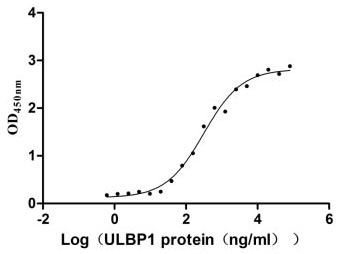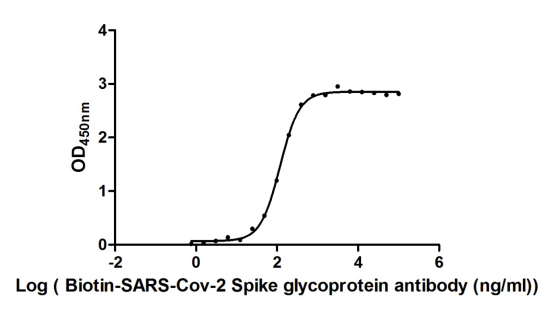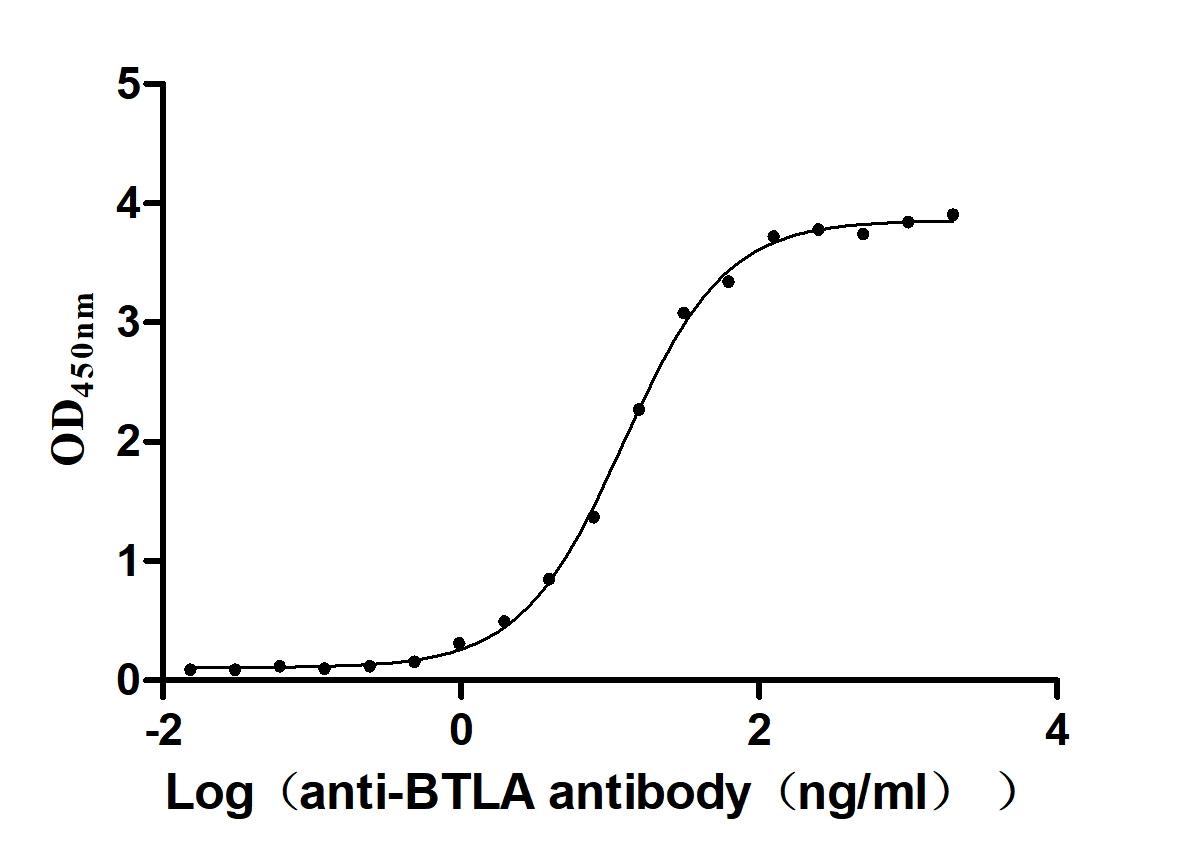Recombinant Mouse Cathepsin K (Ctsk)
-
货号:CSB-YP006192MO
-
规格:
-
来源:Yeast
-
其他:
-
货号:CSB-EP006192MO-B
-
规格:
-
来源:E.coli
-
共轭:Avi-tag Biotinylated
E. coli biotin ligase (BirA) is highly specific in covalently attaching biotin to the 15 amino acid AviTag peptide. This recombinant protein was biotinylated in vivo by AviTag-BirA technology, which method is BriA catalyzes amide linkage between the biotin and the specific lysine of the AviTag.
-
其他:
-
货号:CSB-BP006192MO
-
规格:
-
来源:Baculovirus
-
其他:
-
货号:CSB-MP006192MO
-
规格:
-
来源:Mammalian cell
-
其他:
产品详情
-
纯度:>85% (SDS-PAGE)
-
基因名:
-
Uniprot No.:
-
别名:Ctsk; Cathepsin K; EC 3.4.22.38
-
种属:Mus musculus (Mouse)
-
蛋白长度:Full Length of Mature Protein
-
表达区域:115-329
-
氨基酸序列VPDSID YRKKGYVTPV KNQGQCGSCW AFSSAGALEG QLKKKTGKLL ALSPQNLVDC VTENYGCGGG YMTTAFQYVQ QNGGIDSEDA YPYVGQDESC MYNATAKAAK CRGYREIPVG NEKALKRAVA RVGPISVSID ASLASFQFYS RGVYYDENCD RDNVNHAVLV VGYGTQKGSK HWIIKNSWGE SWGNKGYALL ARNKNNACGI TNMASFPKM
-
蛋白标签:Tag type will be determined during the manufacturing process.
The tag type will be determined during production process. If you have specified tag type, please tell us and we will develop the specified tag preferentially. -
产品提供形式:Lyophilized powder
Note: We will preferentially ship the format that we have in stock, however, if you have any special requirement for the format, please remark your requirement when placing the order, we will prepare according to your demand. -
复溶:We recommend that this vial be briefly centrifuged prior to opening to bring the contents to the bottom. Please reconstitute protein in deionized sterile water to a concentration of 0.1-1.0 mg/mL.We recommend to add 5-50% of glycerol (final concentration) and aliquot for long-term storage at -20℃/-80℃. Our default final concentration of glycerol is 50%. Customers could use it as reference.
-
储存条件:Store at -20°C/-80°C upon receipt, aliquoting is necessary for mutiple use. Avoid repeated freeze-thaw cycles.
-
保质期:The shelf life is related to many factors, storage state, buffer ingredients, storage temperature and the stability of the protein itself.
Generally, the shelf life of liquid form is 6 months at -20°C/-80°C. The shelf life of lyophilized form is 12 months at -20°C/-80°C. -
货期:Delivery time may differ from different purchasing way or location, please kindly consult your local distributors for specific delivery time.Note: All of our proteins are default shipped with normal blue ice packs, if you request to ship with dry ice, please communicate with us in advance and extra fees will be charged.
-
注意事项:Repeated freezing and thawing is not recommended. Store working aliquots at 4°C for up to one week.
-
Datasheet :Please contact us to get it.
相关产品
靶点详情
-
功能:Thiol protease involved in osteoclastic bone resorption. Displays potent endoprotease activity against fibrinogen at acid pH. May play an important role in extracellular matrix degradation. Involved in the release of thyroid hormone thyroxine (T4) by limited proteolysis of TG/thyroglobulin in the thyroid follicle lumen.
-
基因功能参考文献:
- these data indicate that CatK not only plays a major role in bone remodeling but also modulates modeling-based cortical bone formation by degrading periostin and thereby moderating Wnt-beta-catenin signaling. PMID: 28322464
- This study established a possible role of CatK in TLR7 proteolytic activation, Treg immunosuppressive activity, and lupus autoimmunity and pathology. PMID: 28093526
- catK deficiency almost completely blunted the increased vascular remodeling response of apoE-/- mice to flow cessation, possibly by correcting hyperlipidemia-associated pro-inflammatory effects on the peripheral immune response PMID: 27636705
- Cathepsin K expression is increased in the bone of a diabetic mouse model. PMID: 26892148
- Data suggest Ctsk gene, key gene upregulated during osteoclast differentiation, is transcriptionally activated during cell hypoxia-induced mitochondrial dysfunction/disruption; hnRNPA2 (heterogeneous ribonucleoprotein A2) is coactivator in this process. PMID: 25800988
- cathepsin K knockout attenuates age-related decline in cardiac function via suppressing caspase-dependent and caspase-independent apoptosis PMID: 25692548
- Data (including data from studies in knockout/transgenic mice) suggest that Ctsk is involved in inflammatory response and bone resorption in both rheumatoid arthritis and periodontitis; thus, Ctsk appears to play a role in osteoimmune responses. PMID: 25896020
- In a mouse model of post-traumatic osteoarthritis, cathepsin K activity was significantly increased in injured knees relative to uninjured knees. PMID: 25278057
- Gene deletion of cathepsin K in mice accelerated callus size resolution, significantly increased callus mineralized mass, and improved mechanical strength as compared to wild type mice. PMID: 24928497
- synergism between HIV proteins and pro-atherogenic shear stress to increase endothelial cell expression of the powerful protease cathepsin K PMID: 24719048
- in addition to its other effects, the absence of CatK in OCP limits their ability to engraft in a repairing fracture callus compared to WT OCP. PMID: 24590570
- Cardiac mammalian target of rapamycin and extracellular signal-regulated kinases (ERK) signaling cascades were upregulated by pressure overload, the effects of which were attenuated by cathepsin K knockout. PMID: 23529168
- The localization pattern of the intercellular junction proteins E-cadherin and occludin was altered in the colon of Ctsk-/- mice, suggesting potential impairment of the barrier function. PMID: 23152408
- Targeted ablation of Ctsk in hematopoietic cells, or specifically in osteoclasts and cells of the monocyte-osteoclast lineage, resulted in increased bone volume and bone formation rate as well as osteoclast and osteoblast numbers. PMID: 23321671
- cathepsin K contributes to the development of obesity-associated cardiac hypertrophy and may represent a potential target for the treatment to obesity-associated cardiac anomalies. PMID: 23069627
- cathepsin K exocytosis is controlled by PKCdelta through modulation of the actin bundling protein myristoylated alanine-rich C-kinase substrate. PMID: 22806935
- results raise significant concerns regarding in vivo bone phenotypes created using Ctsk(Cre/+) mice and warrant further investigation into the role of Cathepsin K in gametes as well as alternative tools for studying osteoclast-specific gene loss in vivo PMID: 22860046
- CTK plays crucial direct roles in the early to intermediate stage of osteoarthritis development. CTK-positive chondrocytes and synovial cells may be a possible target to prevent disease progression in osteoarthritis. PMID: 21968827
- This study demonstrates that curcumin increases the expression of cathepsins K and L in lung which an effect on lung fibroblast cell behavior. PMID: 22126332
- We propose that cathepsin K activity has an important impact on the development and maintenance of the CNS in mice PMID: 21794126
- variants of ENaC subunits may contribute to the variation of BP response to dietary sodium intake PMID: 21721952
- CatK plays an essential role in abdominal aortic aneurysm formation by promoting T-cell proliferation, vascular SMC apoptosis, and elastin degradation and by affecting vascular cell protease expression and activities. PMID: 21817099
- BK channel controls resorptive osteoclast activity by regulating Cathepsin K release PMID: 21695131
- Airway development is partly regulated by cathepsin K expression contributes to lung development the maintenance of the airway structural integrity via an interaction with TGF-beta1. PMID: 21627832
- Cathepsin K deficiency affected mostly the occurrence and composition of lung granulomas in a murine model of sarcoidosis. PMID: 21251246
- the levels of cathepsin K and MMP-9 increase in the conditioned medium from IL-17A-treated cells PMID: 20937352
- while catK deficiency has major impact on various vasculopathies, it did not affect murine aneurysm formation. PMID: 19775691
- Data indicate that cathepsin K ablation in mice results in reduced body fat content under conditions requiring a rapid accumulation of fat stores. PMID: 17668061
- Results suggest that the accumulation of glycosaminoglycans in murine mucopolysaccharidosis I bone has an inhibitory effect on cathepsin K activity, resulting in impaired osteoclast activity and decreased cartilage resorption. PMID: 19834056
- Cathepsin K-deficient osteoclasts are fully differentiated and are capable of degrading the organic phase of alveolar bone during tooth formation and eruption in CK-/- knockout mice. PMID: 12719657
- cathepsin K has a role in utilization of luminal thyroglobulin for thyroxine liberation PMID: 12782676
- Cathepsin K plays a pivotal role in lung matrix homeostasis under physiological and pathological conditions. PMID: 15161653
- Altogether, these data suggest that while Cat K may contribute to control lung fibrosis, TGF-beta appears to limit its overexpression in response to silica particles PMID: 16045809
- overexpression of the cathepsin K gene under its own promoter in transgenic mice makes them susceptible to progressive synovitis PMID: 16329095
- Scavenger receptor-mediated uptake (particularly by CD36) of modified LDL increased in the absence of catK, resulting in an increased macrophage size because of increased cellular storage of cholesterol esters, thereby enlarging the lysosomes PMID: 16365196
- CatK-deficient mice were generated by targeted disruption of the Ctsk gene and compared their bone structural and mechanical properties with wildtype (WT) controls. PMID: 16753017
- Cathepsin K is a mechanosensitive, extracellular matrix protease that may be involved in arterial wall remodeling and atherosclerosis. PMID: 17098827
- cathepsin K plays a key role in osteoclasts apoptosis and senescence, revealing the importance of osteoclasts senescence in bone homeostasis. PMID: 17210673
- AP-1 stimulates the cathepsin K promoter in RAW 264.7 cells. PMID: 17897792
- results suggest cathepsin K plays an important role in the immune system; pharmacological inhibition or targeted disruption of cathepsin K resulted in defective Toll-like receptor 9 signaling in dendritic cells in response to unmethylated CpG DNA PMID: 18239127
- experiments raise doubts about a crucial role of cathepsin K in arthritic bone destruction PMID: 18240253
- cathepsin K deficiency appears to increase lesion stability in brachiocephalic arteries by maintaining the integrity of the tunica media and by decreasing plaque vulnerability to rupture PMID: 18291403
- essential role of CatK in adipogenesis and body weight gain, possibly via degradation of fibronectin PMID: 18818416
- CTSK may play a role in adipogenesis in early differentiation phases and produce an effect at least partly by degrading type I collagen. PMID: 18840928
- The purpose of this paper is to describe bone mass, strength, resorption, and formation in young adult CatK null mice. PMID: 18845279
- Leucocyte CatK is an important determinant of atherosclerotic plaque composition, vulnerability, and bone remodelling. PMID: 19015136
- cathepsin K interaction with type I collagen is required for 1) the release of cryptic Arg-Gly-Asp motifs during the initial attachment of osteoclasts and 2) termination of resorption PMID: 19028686
- increased biosynthesis of cathepsin K was sufficient to accelerate the osteoclastic bone resorption cycle. PMID: 19118660
- Free cholesterol accumulation in macrophage membranes activates Toll-like receptors and p38 mitogen-activated protein kinase and induces cathepsin K. PMID: 19122179
- the hypercalcification of the cathepsin K-deficient growth plate is due to persistence of calcified cartilage and point to a role of cathepsin K in bone tissue development as well as skeletal remodeling. PMID: 19172215
显示更多
收起更多
-
亚细胞定位:Lysosome. Secreted. Apical cell membrane; Peripheral membrane protein; Extracellular side.
-
蛋白家族:Peptidase C1 family
-
组织特异性:Predominantly expressed in bones. Expressed in thyroid epithelial cells.
-
数据库链接:
KEGG: mmu:13038
STRING: 10090.ENSMUSP00000015664
UniGene: Mm.272085
Most popular with customers
-
Recombinant Human UL16-binding protein 1 (ULBP1) (Active)
Express system: Mammalian cell
Species: Homo sapiens (Human)
-
Recombinant Severe acute respiratory syndrome coronavirus 2 Spike glycoprotein (S), partial (Active)
Express system: Mammalian cell
Species: Severe acute respiratory syndrome coronavirus 2 (2019-nCoV) (SARS-CoV-2)
-
Recombinant Mouse Prolactin receptor (Prlr), partial (Active)
Express system: Mammalian cell
Species: Mus musculus (Mouse)
-
Recombinant Human Desmoglein-3 (DSG3), partial (Active)
Express system: Baculovirus
Species: Homo sapiens (Human)
-
Recombinant Mouse Cytotoxic and regulatory T-cell molecule (Crtam), partial (Active)
Express system: Mammalian cell
Species: Mus musculus (Mouse)
-
Recombinant Macaca fascicularis C-type lectin domain family 4 member C(CLEC4C), partial (Active)
Express system: Mammalian cell
Species: Macaca fascicularis (Crab-eating macaque) (Cynomolgus monkey)
-
Recombinant Human B- and T-lymphocyte attenuator(BTLA), partial (Active)
Express system: Mammalian cell
Species: Homo sapiens (Human)
-
Recombinant Macaca fascicularis Transmembrane 4 L6 family member 1 (TM4SF1)-VLPs (Active)
Express system: Mammalian cell
Species: Macaca fascicularis (Crab-eating macaque) (Cynomolgus monkey)




















